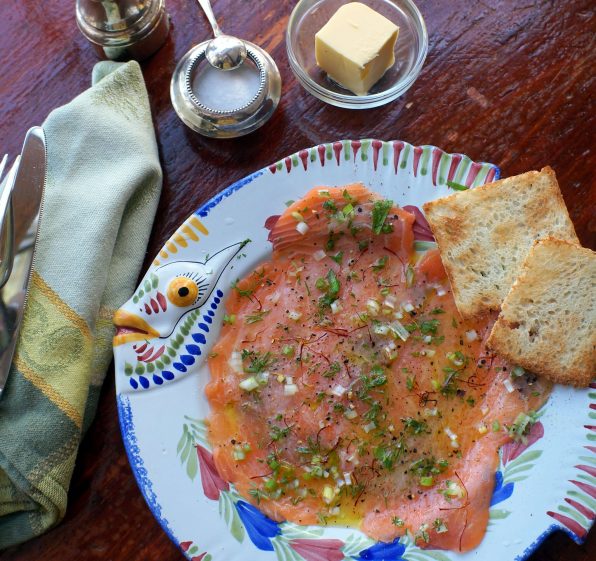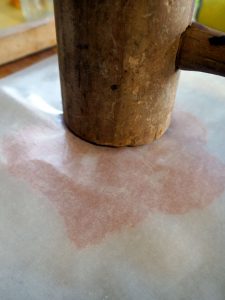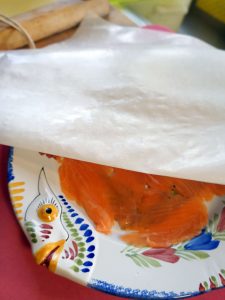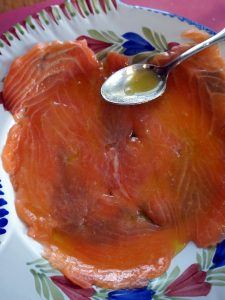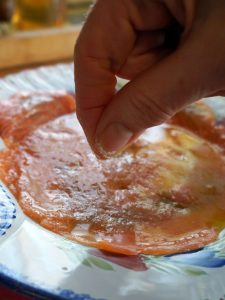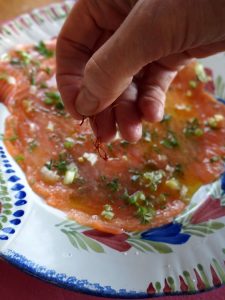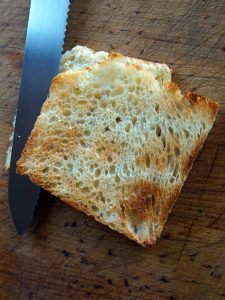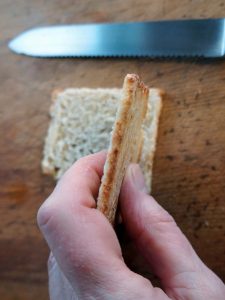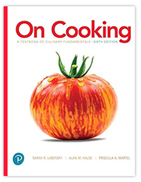Are you looking for something fast and festive? Consider Salmon Carpaccio as a fresh, unfussy main course or light main meal. Think sashimi with a French twist. The saturated color of thin slices of raw salmon says “fancy” but it is forgiving to prepare. Bread bakers take note. Because fish carpaccio needs a crusty baguette or thin slices of pain de mie, it is a great dish to add to your repertoire.
Salmon carpaccio is made from raw salmon pounded into thin, uniform slices. A lemon and olive oil dressing cures the fish. Tender herbs and sliced scallions balance the richness of quality salmon. Saffron is an unexpected embellishment you won’t want to skip.
When you shop for the ingredients, inform your fish monger that you are looking for salmon to be eaten raw. (Some may say a fish is “sushi-grade”.) A quality vendor will be honest about what they have available. Freshness is essential when serving raw fish. And keeping it cold after purchasing and while handling it is also essential.
You’ll want a uniform-size chuck of salmon. (Slicing from an uncut side of salmon is preferable. If you have other uses for salmon or are feeding a crowd, purchase a whole boned side.) This will be easy to slice. But don’t worry about needing advanced knife skills. Pounding pulls all the uneven bits and edges together.
Slice the fish into pieces about 1/3-inch thick. Overlap them into a 4-inch square on sheets of thick wax paper or parchment paper.
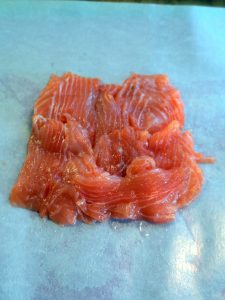
Place another sheet of waxed paper or parchment on top. Then pound the fish out evenly using a flat wooden mallet. Or the bottom of a flat heavy frying pan.
Pound until the fish is about 1/8 – 1/4- inch thick. Run your hands over the paper to feel where you need to pound a little more.
The pounded salmon can be refrigerated for up to 12 hours before serving. Stack the sheets of paper and salmon. Slide the stack into a plastic bag and refrigerate it. This makes serving the dish to a room full of friends easier.
When you’re ready to serve, peel off one sheet of paper then invert the salmon onto the a chilled plate. Carefully peel off the other sheet of paper.
Using the back of a spoon, spread some of the lemon dressing over the fish. Make sure that the dressing touches the entire surface of the salmon.
Careful season it with some coarse salt. Again you want some salt to land on every section of the carpaccio.
Grab a generous pinch of the fresh herbs and scatter them over the salmon. Finish with the saffron.
Melba toast is my preferred accompaniment although thin slices of baguette work well too. Here’s a slice os thick crust less toast that I am slicing in half horizontally in half to make Melba toast.
Kitchen Notebook
We featured fish carpaccio on the menu at Restaurant du Village for many years. We made it from tuna and sea bass but salmon is and was always my favorite. (I also make a salmon tartar that uses raw and smoked salmon, recipe for another time.)
The saffron really makes the dish. It’s something Charlie picked up when he spent a few days in Daniel Boulud’s restaurant kitchen.
Food safety is of utmost concern when preparing and eating raw fish. Here is an excellent and detailed article about the issues surrounding raw fish consumption and preparation at home.
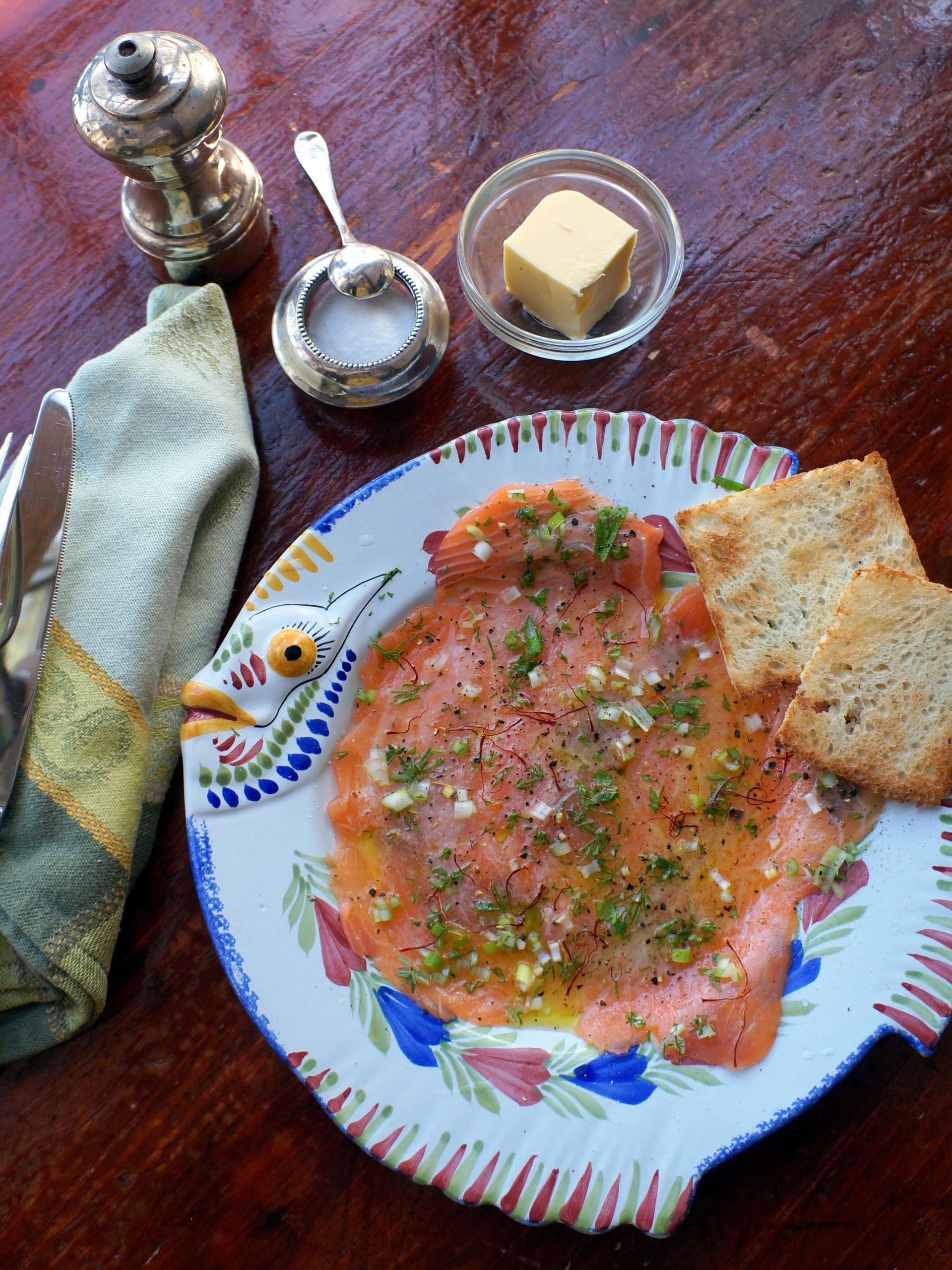
Consider Salmon Carpaccio as a fast, unfussy and fresh first course or light main meal. Think sashimi with a French twist. The saturated color of thin slices of raw salmon says “fancy” but it is forgiving to prepare. Bread bakers take note. Fish carpaccio needs a crusty baguette or thin slices of pain de mie and is a great dish to add to your repertoire.
Saffron is an unexpected detail that really makes this dish. Don’t skip it.
Ingredients
10-12 ounces fresh raw sushi-grade salmon, skinned
Juice of two fresh lemons
2-3 fluid ounces extra virgin olive oil, light fruity
Kosher salt
Fresh chives,chopped fine
Fresh dill, chopped fine
Fresh thyme leaves, chopped fine
Flat leaf parsley, chopped fine
2 scallions, trimmed
Saffron
Fresh ground black or white pepper
Slices of freshly-made toast, crust removed OR Melba Toast or slices of baguette
Unsalted butter
Directions
- Clean, sanitize and dry the cutting board, knives and work area you will be using to prepare the salmon. Wash your hands thoroughly.
- Holding a long sharp knife at a 45 degree angle, cut slices from the salmon approximately 1/3-inch thick.
- Working with one portion at a time, overlap several slices of the salmon into a 4-inch square on a sheet of thick wax paper or parchment paper.
- Place another sheet of wax or parchment paper on top of the salmon. Pound the fish out into an even layer using a flat wooden meat matter or the bottom of a heavy frying pan. Hold the mallet about four inches above the counter and pound gently, moving the mallet around until the fish is about 1/8-1/4 inch thick. Run your hands over the paper to feel where you need to pound a little more.
- Refrigerate the pounded salmon. Prepare the rest of the salmon, refrigerating each pounded portion as you go. Wrap the sheets of pounded salmon into a stack and place them in a plastic bag. Keep refrigerated until ready to serve, for up to 12 hours.
- When ready to serve, whisk together the lemon juice and olive oil in a small bowl. Slice the scallions on the diagonal. Reserve some of the thin slices and chop the rest. Chill serving plates.
- For each serving, remove one sheet of the paper from a portion of the pounded salmon. Invert the salmon on a chilled plate. Peel off the paper.
- Spread some of the lemon dressing onto the salmon. Use the back of the spoon to lightly coat the entire surface with the dressing. Sprinkle the salmon with some salt. Scatter the salmon with the chopped herbs and scallions. Using dry fingers, scatter saffron over the salmon. Grind some black or white pepper over the plate.
- Serve with slices of fresh Melba toast and butter.
Notes
Food safety is of utmost concern when handling and serving raw fish. Here is an excellent and detailed resource on the subject of preparing and eating raw fish at home. https://www.seriouseats.com/2017/05/how-to-prepare-raw-fish-at-home-sushi-sashimi-food-safety.html

